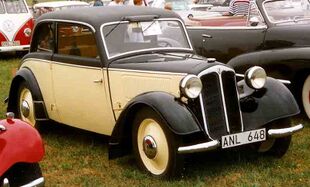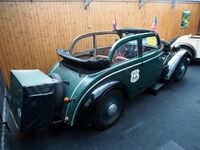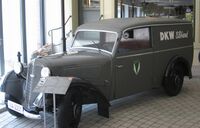Engineering:DKW F7
| DKW F7 Reichsklasse / Meisterklasse | |
|---|---|
 DKW F7 saloon | |
| Overview | |
| Manufacturer | Auto Union AG |
| Production | 1937–1938 |
| Assembly | Zwickau Australia [1] |
| Body and chassis | |
| Class | Subcompact family car (C) |
| Body style | 2-door saloon 2-door cabriolet saloon 2-door coupe cabriolet coupe utility[1] van[1] |
| Layout | FF layout |
| Related | Toyota EA |
| Powertrain | |
| Engine | 584 cc & 692 cc two stroke straight-2 |
| Transmission | 3-speed manual |
| Dimensions | |
| Wheelbase | 2,610 mm (103 in) |
| Length | 3,985 mm (156.9 in) |
| Width | 1,480 mm (58 in) |
| Height | 1,500 mm (59 in) |
| |uk|Kerb|Curb}} weight | 750 kg (1,650 lb) approx |
| Chronology | |
| Predecessor | DKW F5 |
| Successor | DKW F8 |
The DKW F7 is a front-wheel-drive, two-stroke, subcompact family car launched by Auto Union’s DKW division in 1937, succeeding their DKW F5 range. In the F7 update, the slightly smaller entry-level 'Reichsklasse' body was dropped – instead all F7s, including the base trim, now got the slightly longer body previously reserved for the 'Meisterklasse' model.
Some 80,000 of these front-wheel drives were sold until the 1939 DKW F8 successor was released.
The body
The entry level 'Reichsklasse' saloon now shared the hitherto slightly longer body of the 'Meisterklasse' saloon. Otherwise, changes between the F5 and the F7 were mostly at a detail level.
From launch, a 2-door saloon and a 2-door cabriolet saloon, with fixed sides, were offered. In 1938 a full cabriolet 2‑door, the 'Front Luxus Cabriolet', was added to the range.
Engine and running gear
The car has the two cylinder two-stroke engine of its predecessor. The Reichsklasse engine was of 584 cc with an output of 18 bhp (13 kW). The Meisterklasse’s 692 cc engine had an output of 20 bhp (15 kW). Respective claimed top speeds were 80 km/h (50 mph) and 85 km/h (53 mph).[2]
Like all the small DKWs of the 1930s, the F7 had front-wheel drive,[2] which in its era was still very innovative, but in subsequent decades would become the default drive layout in the majority of cars around the world.
Commercial
The popular F7 was replaced by the DKW F8 in 1939. By this time, approximately 80,000 F7s had been built.[3]
Sources
- ↑ 1.0 1.1 1.2 The History of DKW Cars in Australia, heinkelscooter.blogspot.com.au Retrieved 1 May 2016
- ↑ 2.0 2.1 Odin, L.C. World in Motion 1939 – The whole of the year's automobile production. Belvedere Publishing, 2015. ASIN: B00ZLN91ZG.
- ↑ Daniel Vaughan. "1937 DKW F7 - conceptcarz.com". conceptcarz.com. https://www.conceptcarz.com/vehicle/z17078/dkw-f7.aspx.
 |





